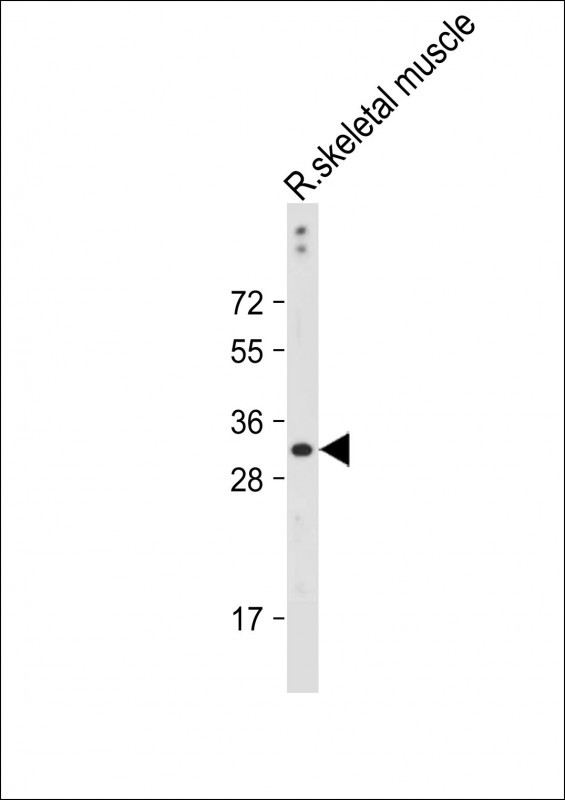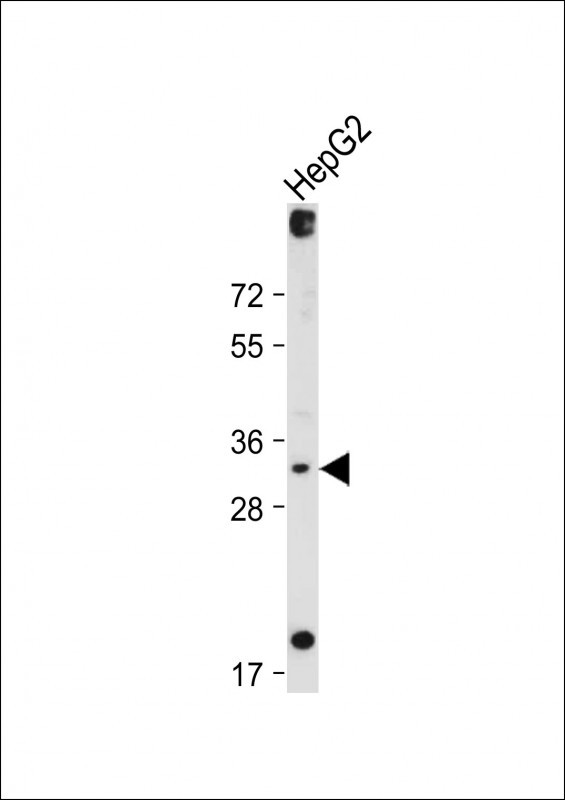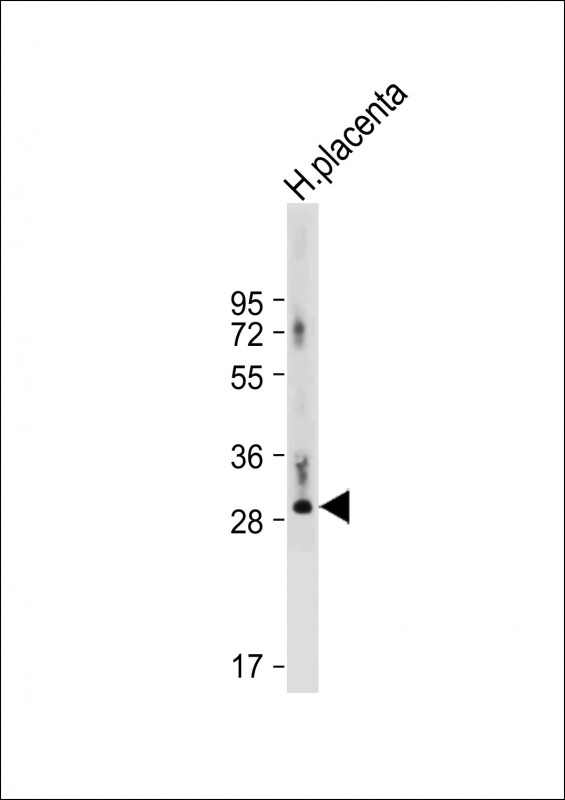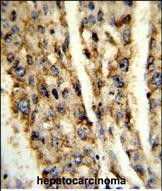DIO3 Antibody (C-term)
Affinity Purified Rabbit Polyclonal Antibody (Pab)
- SPECIFICATION
- CITATIONS
- PROTOCOLS
- BACKGROUND

Application
| WB, IHC-P, E |
|---|---|
| Primary Accession | P55073 |
| Other Accession | NP_001353 |
| Reactivity | Human, Rat |
| Host | Rabbit |
| Clonality | Polyclonal |
| Isotype | Rabbit IgG |
| Calculated MW | 33947 Da |
| Antigen Region | 250-278 aa |
| Gene ID | 1735 |
|---|---|
| Other Names | Type III iodothyronine deiodinase, 5DIII, DIOIII, Type 3 DI, Type-III 5'-deiodinase, DIO3, ITDI3, TXDI3 |
| Target/Specificity | This DIO3 antibody is generated from rabbits immunized with a KLH conjugated synthetic peptide between 250-278 amino acids from the C-terminal region of human DIO3. |
| Dilution | WB~~1:2000 IHC-P~~1:50~100 E~~Use at an assay dependent concentration. |
| Format | Purified polyclonal antibody supplied in PBS with 0.09% (W/V) sodium azide. This antibody is purified through a protein A column, followed by peptide affinity purification. |
| Storage | Maintain refrigerated at 2-8°C for up to 2 weeks. For long term storage store at -20°C in small aliquots to prevent freeze-thaw cycles. |
| Precautions | DIO3 Antibody (C-term) is for research use only and not for use in diagnostic or therapeutic procedures. |
| Name | DIO3 |
|---|---|
| Synonyms | ITDI3, TXDI3 |
| Function | Plays a crucial role in the metabolism of thyroid hormones (TH) and has specific roles in TH activation and inactivation by deiodination (PubMed:7593630, PubMed:12586771, PubMed:12746313, PubMed:18821722). Catalyzes the deiodination of L-thyroxine (T4) to 3,3',5'-triiodothyronine (rT3), 3,5,3'-triiodothyronine (T3) to 3,3'- diiodothyronine (3,3'-T2), 3,5-diiodothyronine (3,5-T2) to 3- monoiodothyronine (3-T1), rT3 to 3',5'-diiodothyronine (3',5'-T2) and 3,3'-T2 to 3'-monoiodothyronine (3'-T1) via inner-ring deiodination (IRD) (PubMed:7593630, PubMed:12586771, PubMed:12746313, PubMed:18821722, PubMed:18339710). Catalyzes the deiodination of 3-T1 to L-thyronine (T0) via outer-ring deiodination (ORD) (PubMed:18821722). Catalyzes the tyrosyl ring deiodinations of 3,3',5,5'-tetraiodothyronamine, 3,3',5'-triiodothyronamine, 3,5,3'- triiodothyronamine, 3,5-diiodothyronamine, 3,3'-diiodothyronamine and 3-iodothyronamine (PubMed:18339710). |
| Cellular Location | Cell membrane; Single-pass type II membrane protein. Endosome membrane; Single-pass type II membrane protein |
| Tissue Location | Expressed in placenta and several fetal tissues. |

Thousands of laboratories across the world have published research that depended on the performance of antibodies from Abcepta to advance their research. Check out links to articles that cite our products in major peer-reviewed journals, organized by research category.
info@abcepta.com, and receive a free "I Love Antibodies" mug.
Provided below are standard protocols that you may find useful for product applications.
Background
DIO3 belongs to the iodothyronine deiodinase family. It catalyzes the inactivation of thyroid hormone by inner ring deiodination of the prohormone thyroxine (T4) and the bioactive hormone 3,3',5-triiodothyronine (T3) to inactive metabolites, 3,3',5'-triiodothyronine (RT3) and 3,3'-diiodothyronine (T2), respectively. This enzyme is highly expressed in the pregnant uterus, placenta, fetal and neonatal tissues, suggesting that it plays an essential role in the regulation of thyroid hormone inactivation during embryological development. This protein contains a selenocysteine (Sec) residue, which is essential for efficient enzyme activity. The selenocysteine is encoded by the UGA codon, which normally signals translation termination. The 3' UTR of Sec-containing genes have a common stem-loop structure, the sec insertion sequence (SECIS), which is necessary for the recognition of UGA as a Sec codon rather than as a stop signal.
References
Bessho, K., et al. Eur. J. Pediatr. 169(2):215-221(2010)
Wallace, C., et al. Nat. Genet. 42(1):68-71(2010)
Aerts, G., et al. Endocrinology 150(11):5171-5180(2009)
Panicker, V., et al. J. Clin. Endocrinol. Metab. 94(5):1623-1629(2009)
Panicker, V., et al. J. Clin. Endocrinol. Metab. 93(8):3075-3081(2008)
If you have used an Abcepta product and would like to share how it has performed, please click on the "Submit Review" button and provide the requested information. Our staff will examine and post your review and contact you if needed.
If you have any additional inquiries please email technical services at tech@abcepta.com.













 Foundational characteristics of cancer include proliferation, angiogenesis, migration, evasion of apoptosis, and cellular immortality. Find key markers for these cellular processes and antibodies to detect them.
Foundational characteristics of cancer include proliferation, angiogenesis, migration, evasion of apoptosis, and cellular immortality. Find key markers for these cellular processes and antibodies to detect them. The SUMOplot™ Analysis Program predicts and scores sumoylation sites in your protein. SUMOylation is a post-translational modification involved in various cellular processes, such as nuclear-cytosolic transport, transcriptional regulation, apoptosis, protein stability, response to stress, and progression through the cell cycle.
The SUMOplot™ Analysis Program predicts and scores sumoylation sites in your protein. SUMOylation is a post-translational modification involved in various cellular processes, such as nuclear-cytosolic transport, transcriptional regulation, apoptosis, protein stability, response to stress, and progression through the cell cycle. The Autophagy Receptor Motif Plotter predicts and scores autophagy receptor binding sites in your protein. Identifying proteins connected to this pathway is critical to understanding the role of autophagy in physiological as well as pathological processes such as development, differentiation, neurodegenerative diseases, stress, infection, and cancer.
The Autophagy Receptor Motif Plotter predicts and scores autophagy receptor binding sites in your protein. Identifying proteins connected to this pathway is critical to understanding the role of autophagy in physiological as well as pathological processes such as development, differentiation, neurodegenerative diseases, stress, infection, and cancer.





